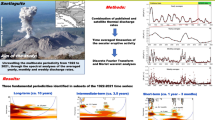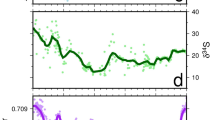Abstract
The Gėluva age (late Homerian: Silurian) is an important interval of time during which one of the major episodes of mass extinction occurred, affecting many clades of marine organisms. In this study, we investigated a stratigraphic series of gamma logs in the Viduklė-61 well. To test the possible presence of sedimentary cycles, we applied wavelet and other time-series analysis techniques. As a result, we found two cycles with different periods: a 16.7-m-long cycle and a 6.7-m-long cycle. Based on our calculations, the cycles are best explained as being caused by two Milankovitch eccentricity cycles (400 and 100 kyr, respectively). If this interpretation is correct, then it gives us a good tool for understanding the tempo of the lundgreni extinction event and subsequent biotic recovery.
Similar content being viewed by others
Keywords
The main objective of this study is to examine the possible application of wavelet and other spectral analyses to Silurian stratigraphy using the geological section from the Lithuanian part of the Silurian Baltic Basin. To better understand the structure of the geophysical signal and its geological meaning, we performed two types of spectral analyses: wavelet time–frequency decomposition and Lomb frequency decomposition, with analyses being performed using the PAST statistical package (Hammer et al. 2001). Spectral analyses transform original signals into a series of simple functions, such as sines and cosines in the most well known of this type (Fourier analysis), and make it more intelligible with regard to further qualitative and quantitative interpretations. Wavelet analysis is a powerful methodology developed for searching for and representing cycles, and has been used previously in cyclostratigraphic studies (e.g., Prokoph and Agterberg 2000).
The type section of the Gėluva regional stage is in Jakšiai-104 borehole, which spans a depth interval of 813–776.9 m (Paškevičius et al. 1994). The lower boundary of the Gėluva regional stage is marked by the upper boundary of the lundgreni Biozone, and the upper boundary is marked by the lower boundary of the nilssoni Biozone. New material has now been obtained from the Viduklė-61 well, which is located in the clayey Silurian facies zone of Lithuania. The biozones of lundgreni (upper part) parvus, praedeubeli, deubeli, ludensis, and nilssoni (lower part) have been distinguished in the studied interval of the Viduklė-61 core (Fig. 1a). There is one bentonite layer in the parvus Biozone at a depth of 1308 m. According to the geochemical data, this is Grötlingbo bentonite (Kiipli et al. 2008).
a Gėluva regional stage lithology, graptolite biozones, gamma log, and interpretation based on wavelet analysis for fourth- and fifth-order cycles in the Viduklė-61 well. b Wavelet scalogram, where x denotes the length of cycles, y denotes the position of measurements, and colour intensity represents the power of the given wavelength. c Lomb spectrogram, where x denotes the length of cycles, y denotes the power of given harmonics, and CI 99 % is the 99 % confidence interval for the power of harmonics
Natural gamma radiation depends on the abundance of 40K, 232Th, and 238U isotopes in sedimentary rocks, and in the Viduklė-61 core the Gėluva regional stage is composed mainly of carbonates (Fig. 1a), with specific minerals such as glauconite being absent. Therefore, the gamma log essentially mirrors the concentrations of clayey and organic material in the rocks or, in other words, mirrors the patterns of sedimentation that produced them.
Prior to conducting time series analyses, we detrended the signal of log data in order to lower bias, which could otherwise artificially distort lower-frequency (longer-period) harmonics. The trend line was calculated as a second order polynomial curve (y = 2.883x + 0.001121x2 + 1865, where y is the value of gamma ray radiation and x is the negative depth of the sample in the borehole in metres), and was subsequently subtracted from the original series of data. During wavelet analysis of logs, we chose the common Morlet “mother wavelet” function, which is known to be fairly robust in most cases (Hammer and Harper 2006).
We found two clusters of periodicities with wavelengths of 16.7 and 6.7 m, whose power spectra were statistically significant (>99 % CI). Those periodicities could be traced through all spans of the analysed segment of the section, with higher magnitudes of oscillations being observed in the lower part of the section (Fig. 1b). The same clusters of peaks that passed the 99 % confidence intervals were also found when we performed Lomb spectral analysis (Fig. 1c). We interpret these as artefacts of uneven sedimentation, which distorted two original discrete periodicities, with wavelengths of approximately 16.7 and 6.7 m.
To estimate the approximate time spans of the identified periodicities, we used two published dates (Cramer et al. 2012). One of the dates was derived from Grötlingbo bentonite (428.45 ± 0.35 Ma), and we also used the age of the Wenlock–Ludlow boundary (427.86 ± 0.32 Ma). Assuming that the sedimentation rate at the given temporal scale was approximately constant through the entire analysed section, we found proportionality between the thickness of sedimentary succession and its time span. On average, 17,933 yr spanned 1 m of rock. This gives us approximate estimates of the lengths of the identified sedimentary cycles. Based on these calculations, long cycles are about 300,000 yr and short cycles are about 120,000 yr. Given the nature of the sedimentary systems and all the analytical uncertainties, these estimates should be seen only as indicators of the orders of magnitude of characteristic time scales of cyclic processes.
In the analysed section of the Viduklė-61 core, we observe almost three full long cycles and eight short cycles (Fig. 1b). We interpret both periodicities revealed by the wavelet and Lomb spectral analyses as being caused by long (400-kyr) and short (100-kyr) Milankovitch eccentricity cycles (Zachos et al. 2001). However, there are some difficulties with this interpretation, because in our analysed section each long cycle corresponds approximately to three short cycles. In theory, there should be four short eccentricity cycles per one long eccentricity cycle. This discrepancy between theory and the observed patterns could be resolved in two alternative ways. First, long periodicities might be caused by processes other than astronomical forcing, such as convergent tectonism or unsteadiness in mantle convection (Miall 2010). Second, it is possible that during maximal regression episodes of long cycles, one in four of the smaller cycles was not reflected in the sedimentary succession due to the absence of accumulation and/or due to accumulated sediments being destroyed by subsequent transgressions. If the second explanation is correct, then the observations are compatible with the Milankovitch-based explanations.
References
Cramer, B. D., Condon, D. J., Söderlund, U., Marshall, C., Worton, G. J., Thomas, A. T., et al. (2012). U-Pb (zircon) age constraints on the timing and duration of Wenlock (Silurian) paleocommunity collapse and recovery during the ‘Big Crisis’. Geological Society of America Bulletin,124, 1841–1857.
Hammer, Ø., Harper, D. A. T., & Ryan, P. D. (2001). PAST: Paleontological statistics software package for education and data analysis. Palaeontologia Electronica,4(1), 9.
Hammer, Ø., & Harper, D. A. T. (2006). Paleontological data analysis (351 p). Oxford: Wiley–Blackwell.
Kiipli, T., Radzevičius, S., Kallaste, T., Motuza, V., Jeppsson, L., & Wickström, M. L. (2008). Wenlock bentonites in Lithuania and correlation with bentonites from sections in Estonia Sweden and Norway. GFF,130(4), 203–210.
Miall, D. A. (2010). The geology of stratigraphic sequences (522 p). Berlin: Springer.
Paškevičius, J., Lapinskas, P., Brazauskas, A., Musteikis, P., & Jacyna, J. (1994). Stratigraphic revision of the regional stages of the Upper Silurian part in the Baltic Basin. Geologija (Vilnius),17, 64–87.
Prokoph, A., & Agterberg, F. P. (2000). Wavelet analysis of well-logging data from oil source rock, Egret Member, offshore eastern Canada. AAPG Bulletin,84(10), 1617–1632.
Zachos, J., Pagani, M., Sloan, L., Thomas, E., & Billups, K. (2001). Trends, rhythms, and aberrations in global climate 65 Ma to present. Science,292(5517), 686–693.
Acknowledgments
This research was supported by the Science Council of Lithuania MIP-034/2012, and it is a contribution to IGCP 591.
Author information
Authors and Affiliations
Corresponding author
Editor information
Editors and Affiliations
Rights and permissions
Copyright information
© 2014 Springer-Verlag Berlin Heidelberg
About this paper
Cite this paper
Radzevičius, S., Spiridonov, A., Brazauskas, A. (2014). Application of Wavelets to the Cyclostratigraphy of the Upper Homerian (Silurian) Gėluva Regional Stage in the Viduklė-61 Deep Well (Western Lithuania). In: Rocha, R., Pais, J., Kullberg, J., Finney, S. (eds) STRATI 2013. Springer Geology. Springer, Cham. https://doi.org/10.1007/978-3-319-04364-7_84
Download citation
DOI: https://doi.org/10.1007/978-3-319-04364-7_84
Published:
Publisher Name: Springer, Cham
Print ISBN: 978-3-319-04363-0
Online ISBN: 978-3-319-04364-7
eBook Packages: Earth and Environmental ScienceEarth and Environmental Science (R0)





